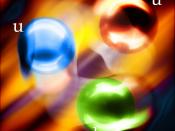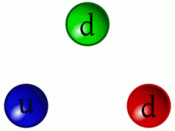Quarks
Quarks- any group of subatomic particles believed to be among the basic components if matter
Quarks are believed to be the fundamental constituents of matter, and have no apparent structure. They are the particles that make up protons and neutrons, which make up the nucleus of atoms. Also, particles that interact by means of the strong force, the force that holds parts of the nucleus together, are explained in terms of quarks. Other baryons are explained in terms of quarks(1985 Quarks).
Quarks have mass and exhibit spin, the type of intrinsic angular momentum corresponding to rotation around an axis, equal to half the basic quantum mechanical unit of angular momentum, obeying Pauli's exclusion principle. This principle that no two particles having half integral spin can exist in the same quantum state(1985 Quarks).
Quarks always occur in combination with other quarks, they never occur alone. Physicists have attempted to knock a single quark free from a group using a particle accelerator, but have failed.
Mesons contain a quark and an antiquark, up, down, and strange, while baryons contain three quarks distinguished by flavours. Each has a charge that is a fraction of that of an electron. Up and down quarks make up protons and neutrons, and can be observed in ordinary matter. Strange quarks can be observed in omega-minus and other short lived subatomic particles which play on part in ordinary matter(1985 Quarks).
The interpretation of quarks as physical entities poses two problems. First, sometimes two or three identical quarks have to be in the same quantum state which, because they have to have half integral spin, violates Pauli's exclusion principal. Second, quarks appear to not be able to be separated from the particles they make up. Although the force holding the quarks together is strong it is improbable that...


